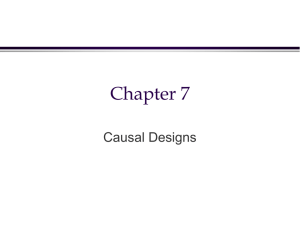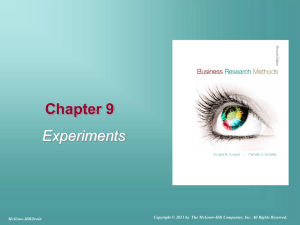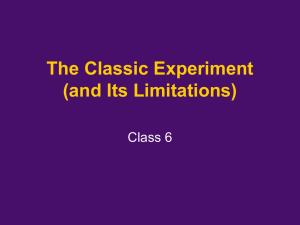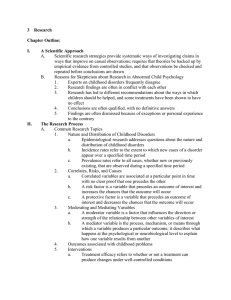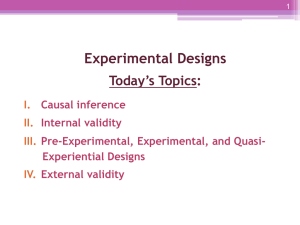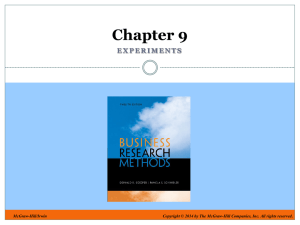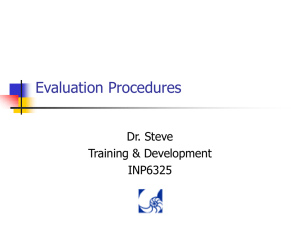Chapter 7
advertisement
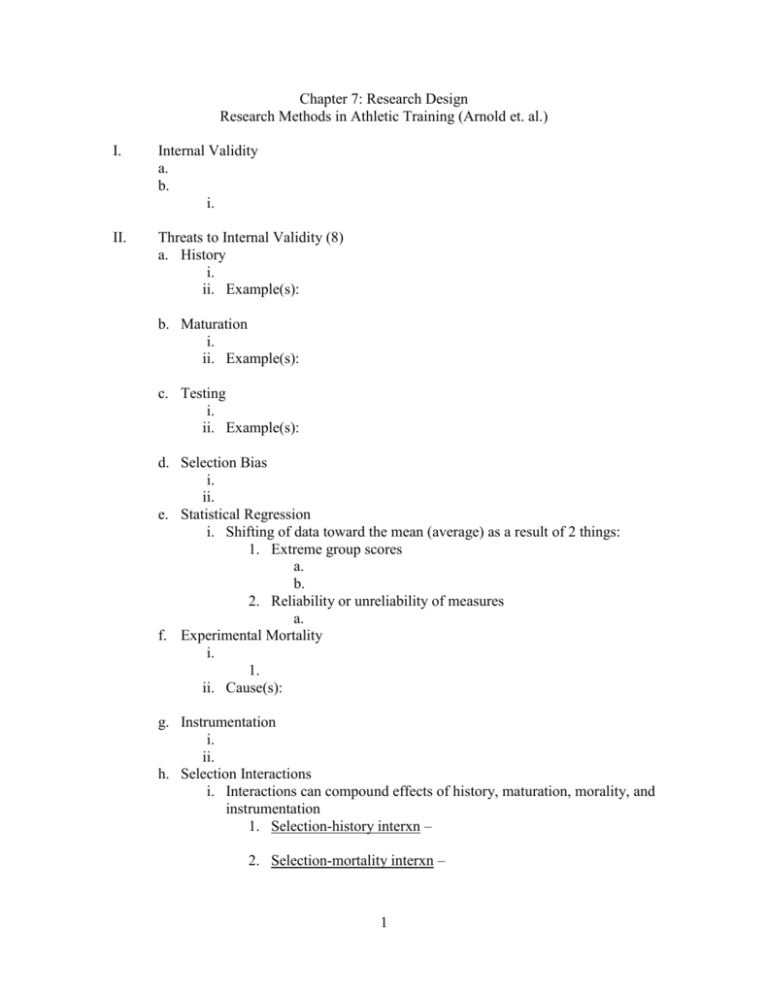
Chapter 7: Research Design Research Methods in Athletic Training (Arnold et. al.) I. Internal Validity a. b. i. II. Threats to Internal Validity (8) a. History i. ii. Example(s): b. Maturation i. ii. Example(s): c. Testing i. ii. Example(s): d. Selection Bias i. ii. e. Statistical Regression i. Shifting of data toward the mean (average) as a result of 2 things: 1. Extreme group scores a. b. 2. Reliability or unreliability of measures a. f. Experimental Mortality i. 1. ii. Cause(s): g. Instrumentation i. ii. h. Selection Interactions i. Interactions can compound effects of history, maturation, morality, and instrumentation 1. Selection-history interxn – 2. Selection-mortality interxn – 1 III. Strategies to counteract threats to internal validity (6) a. Random Assignment i. ii. 1. 2. When control group is not possible, b. Statistical Controls i. 1. Example(s): ii. 1. Example(s): c. Matched Pairs i. 1. Example(s): ii. 1. Example(s): d. Placebos i. 1. ii. Placebo ≠ Control 1. 2. e. Blinding i. Two types 1. Single-blind a. 2. Double-blind a. b. f. Subject Characteristics i. ii. Example(s): 2 IV. Basic Research Designs (Table 7-1, p. 87) a. Differ in 4 major ways: i. How many groups are studied ii. How many subjects are assigned to groups iii. When the measures are taken iv. How many measures are taken b. Pre-experimental Designs – participants are not assigned to either a control or experimental group i. One-shot 1. 2. 3. ii. One-group Pretest-Posttest 1. 2. 3. iii. Static group comparison 1. 2. 3. iv. Experimental Designs – establish cause and effect between Tx and measurement of interest by using control groups and random assignment v. Randomized Group 1. a. 2. vi. Pretest-Posttest Randomized Groups 1. 2. 3. a. Remember 4. a. b. 5. 6. Disadvantages a. b. c. c. Quasi-experimental Designs – attempt to apply experimental principles to the field setting; commonly use multiple groups and multiple observations after a single observation i. Nonequivalent Control Group 1. 2. 3 a. 3. ii. Time Series 1. 2. a. Figure 7-2, p. 92 3. 4. iii. Reversal 1. a. Figure 7-3, p. 93 2. 3. a. d. Single-Subject Designs i. ii. e. Nonexperimental Designs i. Establishes a relationship between 2 variables using statistical techniques 1. 2. ii. V. External Validity a. b. Generalizability = VI. Threats to External Validity (4) a. Multiple Treatment Interference i. 1. 2. Example(s): b. Interactive Effects of Testing i. ii. iii. c. Selection-Treatment Interaction i. ii. d. Reactive Effects of Experimental Arrangements i. ii. iii. 4 VII. Solutions to Common Problems a. How do I control fatigue and practice effects? i. To prevent fatigue, make sure that appropriate time intervals occur between measurements ii. To prevent practice effects, include familiarization sessions prior to data collection to assure the learning of the task is complete iii. Counterbalancing to minimize/equalize fatigue and practice effects 1. Alternate the order of Tx to insure they occur equally at all time points b. Can randomization fail? i. No. It ensures that any differences that do exist between groups is random ii. Random assignment does not ensure that the groups will be exactly the same, just that the differences will be random c. When should I blind a study? i. Participants should be blinded any time a placebo is used ii. Researchers should be blinded any time they could have an effect on the Tx or be biased by knowledge of the results VIII. Summary a. Goal = i. Minimize threats to internal and external validity 5
